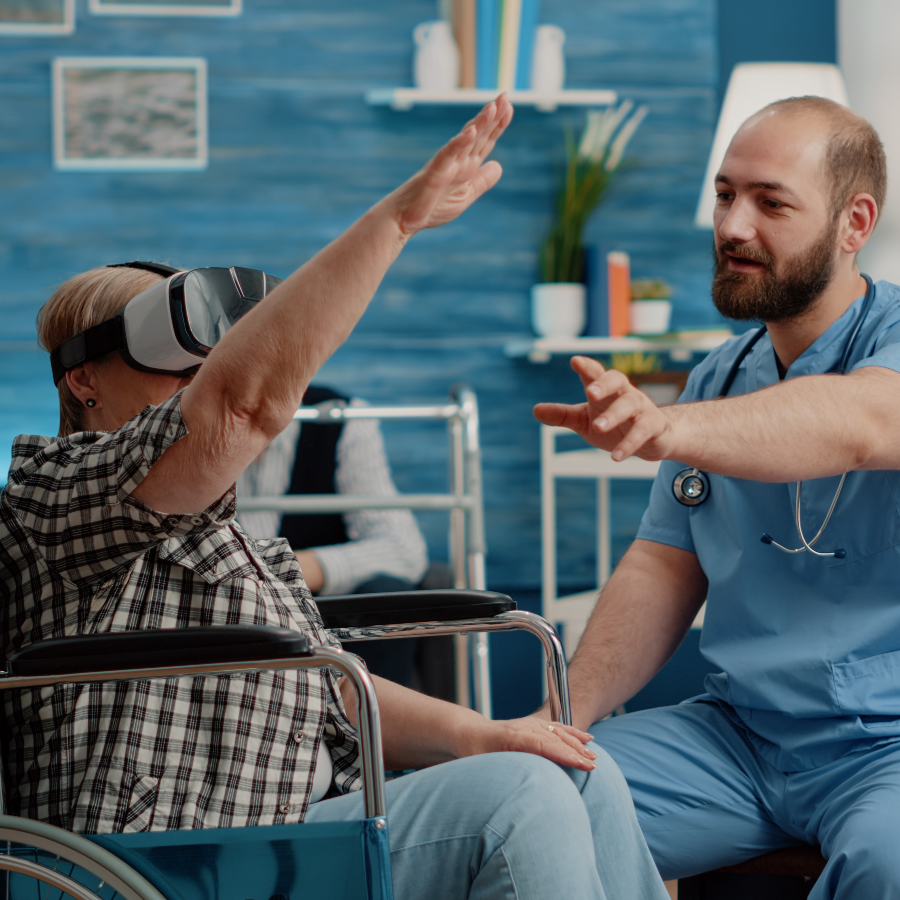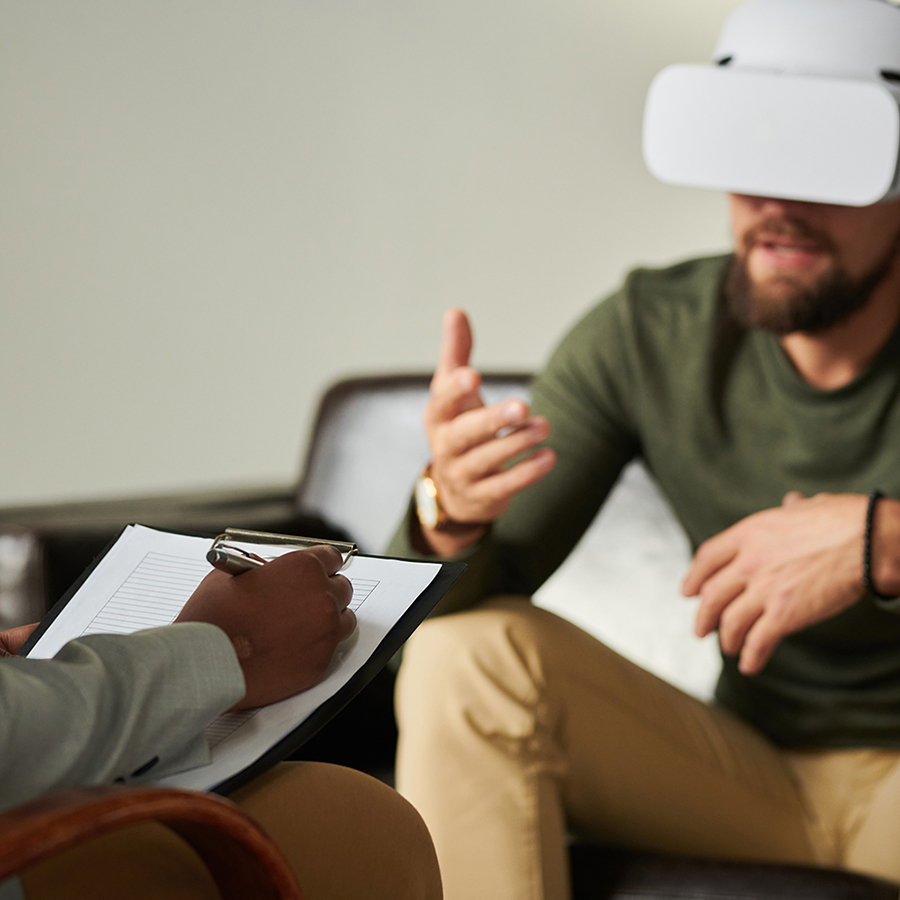Virtual reality therapy is transforming mental health and physical rehabilitation. It creates immersive environments to treat conditions like PTSD and chronic pain. So, what is virtual reality therapy? To understand, one must recognize its ability to offer controlled, interactive scenarios for patients. A virtual reality app development company is crucial in designing these specialized applications.
Using virtual reality as therapy provides realistic simulations that aid recovery and enhance traditional treatment methods. This technology opens new avenues for patient engagement and effective therapy, offering a unique, immersive experience tailored to individual needs. Virtual reality therapy allows therapists to create safe, controlled environments where patients can confront and manage their fears.
Such an innovative approach reduces the stigma associated with traditional therapy methods. Patients often feel more comfortable engaging in virtual settings, leading to better outcomes. Collaboration with a virtual reality app development company ensures the creation of high-quality therapeutic tools. These tools are tailored to individual patient needs, providing a more personalized approach to treatment. The growing acceptance of virtual reality as therapy signifies a shift towards more modern, effective, and patient-friendly therapeutic practices.
What Is Virtual Reality Therapy? Discovering the Basics
Virtual reality therapy, a cutting-edge approach in healthcare, utilizes immersive environments to treat various conditions. To define virtual reality therapy, it involves the use of VR technology to create controlled, interactive scenarios where patients can engage in therapeutic exercises. This method offers significant benefits for both mental health and physical rehabilitation.
Understanding how virtual reality therapy works involves exploring its key components. Patients wear VR headsets, immersing them in simulated environments replicating real-world settings or creating new ones. These environments can be customized to address specific therapeutic needs, allowing patients to confront and manage their issues safely and controlled.
A virtual reality app development company designs these applications, ensuring they meet therapeutic standards and are tailored to individual patient needs. The use of VR as therapy is growing due to its effectiveness in treating conditions such as PTSD, anxiety disorders, and chronic pain. By offering realistic simulations, VR therapy helps patients develop coping strategies and improve their overall well-being.
Unveiling the Concept and Key Insights of VR Therapy
Virtual reality training design and development play a key role in the success of VR therapy. Developing practical VR therapy applications requires a deep understanding of therapeutic goals and patient needs. The design process involves creating immersive environments that are both engaging and therapeutic.
Key insights into VR therapy highlight its versatility and effectiveness. Virtual reality training can simulate various scenarios, from everyday situations to complex therapeutic exercises. This allows patients to practice and develop skills in a controlled environment, enhancing their ability to manage real-life challenges.
A well-designed VR therapy program includes personalized scenarios that cater to each patient's unique needs. For instance, a patient with social anxiety might engage in virtual social interactions to build confidence and reduce anxiety. The involvement of skilled professionals in the development process ensures that VR therapy applications are both safe and effective. Overall, integrating virtual reality training design and development into therapy offers a modern approach to treatment, providing patients with innovative tools to support their mental and physical health.
History and Evolution of VR Therapy
The history of virtual reality therapy dates back to the early experiments with VR technology in the 1990s. Initially used for military training and flight simulations, VR technology soon found applications in the healthcare sector. Virtual reality simulations provided new opportunities for treating mental health conditions and physical rehabilitation.
Over the years, advancements in VR technology have significantly improved the quality and accessibility of VR therapy. Early VR systems were bulky and expensive, limiting their use to specialized facilities. However, recent developments have made VR headsets more affordable and user-friendly, enabling broader adoption in clinical settings.
The evolution of VR therapy has seen its application expand to various therapeutic areas. Today, virtual reality simulations are used to treat conditions such as PTSD, phobias, and chronic pain. The ability to create immersive and interactive environments has proven beneficial in helping patients confront and manage their symptoms.
Continued advancements in VR technology and its integration into healthcare promise to further enhance the effectiveness and accessibility of VR therapy. As the field evolves, it will likely see even more innovative applications, providing patients with cutting-edge tools to support their mental and physical well-being.
Types of Virtual Reality Therapy

Virtual reality therapy encompasses several types, each tailored to address specific therapeutic needs. One common type is exposure therapy, used to treat anxiety disorders and PTSD. In this approach, patients are gradually exposed to feared situations in a controlled VR environment, helping them build resilience and reduce anxiety over time.
Another type is pain management therapy, where VR distracts patients from their pain by immersing them in engaging virtual worlds. This method has effectively reduced chronic pain and discomfort during medical procedures.
Cognitive-behavioral therapy (CBT) also benefits from VR applications. VR environments simulate real-life scenarios, allowing patients to practice coping strategies and social skills in a safe setting. This approach is particularly useful for treating social anxiety and depression.
The potential of virtual reality training solutions extends to physical rehabilitation as well. Patients recovering from injuries can use VR exercises to improve mobility and strength. These exercises can be customized to match the patient's progress and needs, providing a dynamic and adaptable rehabilitation process.
Virtual reality therapy also includes mindfulness and relaxation programs. These VR experiences guide patients through meditation and relaxation techniques, promoting mental well-being and stress reduction. By offering a variety of therapeutic options, virtual reality therapy addresses a wide range of mental and physical health issues.
How Does Virtual Reality Therapy Work? Understanding the Process
Virtual reality therapy integrates VR technology into healthcare to create immersive therapeutic experiences. Patients wear VR headsets, engaging with tailored virtual environments designed to address specific conditions. Virtual reality in healthcare enables controlled exposure to therapeutic scenarios, enhancing patient engagement and treatment effectiveness. This approach is used for mental health, pain management, and physical rehabilitation, offering a versatile tool for modern therapy. The process involves collaboration with a virtual reality app development company to create high-quality, therapeutic VR applications that meet patient needs.
Equipment and Technology in Virtual Reality Therapy
Virtual reality and therapy are interconnected through advanced equipment and technology. The primary tool is the VR headset, which immerses patients in virtual environments. These headsets range from high-end models with intricate tracking systems to more accessible versions compatible with smartphones.
Hand controllers are often used to interact with the virtual world, allowing patients to manipulate objects and navigate through scenarios. In some cases, full-body motion tracking is employed, capturing the patient's movements to enhance the realism of the experience.
Software is a significant component developed by virtual reality app development companies to meet specific therapeutic needs. This software creates immersive environments where therapy takes place, from calming landscapes for relaxation to challenging scenarios for exposure therapy. Haptic feedback devices provide tactile sensations, adding another layer of realism. These devices can simulate the feeling of objects and surfaces, making the virtual experience more engaging.
The integration of advanced graphics and sound systems ensures that the virtual environments are realistic and immersive. High-resolution displays and spatial audio contribute to the therapy's overall effectiveness. The combination of sophisticated hardware and specialized software allows virtual reality therapy to offer unique and effective therapeutic experiences.
Inside a Session: Structure and Experience
A virtual reality therapy session follows a structured format to ensure effectiveness and patient comfort. Initially, the therapist discusses the patient's goals and current condition to tailor the session accordingly. This personalized approach helps address specific therapeutic needs.
During a session, the patient wears a VR headset and, if necessary, uses hand controllers. In virtual reality physical therapy, the patient might perform exercises designed to improve mobility and strength. The virtual environment can simulate real-world scenarios, such as walking in a park or climbing stairs, providing a safe and controlled space for rehabilitation.
The therapist monitors the patient's responses and adjusts the session as needed. This real-time feedback is crucial for maximizing the therapeutic benefits. Patients can interact with virtual objects, complete tasks, and practice coping strategies within the immersive environment. Sessions typically last between 30 minutes to an hour, depending on the therapy type and patient's needs. After the session, the therapist reviews the patient's progress and discusses any adjustments for future sessions.
The immersive nature of virtual reality therapy enhances patient engagement and can lead to improved outcomes. By providing a realistic and interactive experience, virtual reality physical therapy helps patients build skills and confidence in managing their conditions.
The Therapist's Role in Virtual Reality Therapy
Therapists play a vital role in the success of virtual reality therapy. Their expertise ensures that virtual reality therapy software is used effectively to meet each patient’s unique needs. Therapists begin by assessing the patient’s condition and determining the appropriate virtual scenarios for treatment. During sessions, therapists guide patients through the VR experience, offering support and adjustments as needed. They interpret the patient’s interactions within the virtual environment and provide real-time feedback to enhance the therapeutic process.
Therapists also collaborate with virtual reality app development companies to design and refine therapy programs. Their input helps create more effective and tailored VR therapy applications.
Outside of sessions, therapists review data collected by the VR software to monitor progress and make informed decisions about future treatments. This data-driven approach ensures that therapy remains personalized and responsive to the patient’s evolving needs.
The therapist’s role extends to educating patients on how to use VR equipment safely and effectively. They ensure patients feel comfortable with the technology, which is crucial for maximizing the therapeutic benefits. By combining clinical expertise with advanced technology, therapists ensure that virtual reality therapy is a powerful tool for improving patient outcomes.
Advantages of Virtual Reality Therapy: Benefits You Can't Ignore
Virtual reality depression therapy offers immersive experiences that help patients manage symptoms. Its applications extend to various conditions, providing effective and engaging treatment options.
How Virtual Reality Therapy Holds Patient Attention
Virtual reality therapy excels at capturing and maintaining patient attention. In virtual reality and physical therapy, patients engage in interactive exercises that feel like games, making therapy sessions more enjoyable and motivating. The immersive nature of VR ensures that patients remain focused on their rehabilitation exercises, leading to better outcomes.
In virtual reality occupational therapy, patients perform tasks in simulated environments that mimic daily activities. This realistic approach helps them develop and refine skills needed for daily living. The engaging nature of VR keeps patients invested in their progress, which enhances the therapeutic process.
Virtual reality in medical training also highlights its ability to hold attention. Medical students and professionals can practice procedures in a safe, controlled environment, improving their skills and confidence. The interactive and immersive experiences provided by VR make learning more effective and engaging. In general, the ability of virtual reality therapy to hold patient attention significantly contributes to its success in various therapeutic and training contexts.
Treating Various Conditions with Virtual Reality Therapy
Virtual reality for therapy addresses various conditions, offering tailored treatment options. For mental health issues like PTSD and anxiety, VR provides controlled exposure to triggers, helping patients build coping strategies. The immersive environments create a safe space for patients to confront and manage their fears.
Chronic pain management also benefits from virtual reality therapy. Patients engage in VR experiences that distract them from pain, reducing their perception of discomfort. This approach has shown significant promise in improving the quality of life for those with persistent pain conditions.
Physical rehabilitation utilizes VR to create engaging exercises that promote recovery. Patients recovering from injuries or surgeries perform movements in virtual settings that mirror real-life activities. This method accelerates rehabilitation by making exercises more enjoyable and motivating.
Additionally, VR therapy is used for phobias, allowing patients to face their fears in a controlled environment. This gradual exposure helps reduce phobic responses over time. By offering diverse applications, virtual reality therapy effectively treats various conditions, enhancing patient outcomes and well-being.
The Soothing Power of Virtual Reality Therapy
Using virtual reality in therapy provides a calming and soothing experience for patients. Immersive environments designed for relaxation and mindfulness help reduce stress and anxiety. Patients can escape to serene virtual landscapes, engaging in guided meditation or breathing exercises that promote mental well-being.
For individuals undergoing medical procedures, VR serves as a distraction tool, alleviating anxiety and discomfort. Patients can immerse themselves in calming virtual worlds, which helps reduce the perception of pain and anxiety associated with medical treatments.
In therapy sessions, VR can create a peaceful setting for patients to explore their thoughts and emotions. Its immersive nature makes it easier for patients to engage in therapeutic exercises, leading to more effective outcomes.
The soothing power of virtual reality therapy also extends to pain management. Patients experiencing chronic pain can find relief in virtual environments that distract them from discomfort. VR therapy enhances overall patient comfort and supports mental health by providing a sense of calm and relaxation.
Disadvantages of Virtual Reality Therapy: Challenges to Consider
Virtual reality therapy faces significant challenges, including high costs, potential health risks, and technological limitations. These factors can hinder its widespread adoption and effectiveness in therapeutic settings.
The Cost Barrier
Implementing virtual reality in therapy can be expensive. Advanced VR headsets and necessary accessories require substantial investment, which can be a financial strain for smaller clinics and individual practitioners. This limits the availability of VR therapy to a broader audience.
- Developing and maintaining software. Virtual reality app development companies must create and update software tailored to therapeutic needs, adding to the overall cost.
- Insurance coverage. Currently, insurance coverage for VR therapy is limited, making it an out-of-pocket expense for many patients.
- Additional equipment costs. Besides headsets, therapy often requires other equipment like motion sensors and specialized controllers, further increasing expenses.
Patients and providers alike may find these financial burdens discouraging, potentially preventing them from accessing VR therapy's benefits.
Understanding the Risks
Virtual reality therapy, while beneficial, comes with risks that need careful consideration. Prolonged VR use can cause symptoms such as eye strain, headaches, and nausea, often referred to as "VR sickness." These physical discomforts may deter patients from fully engaging in therapy sessions.
- Over-reliance on VR. There's a danger of patients becoming too dependent on virtual environments, which might impede their ability to handle real-world situations effectively.
- Privacy and data security. Using VR in therapy involves collecting sensitive patient information, necessitating stringent data protection measures to maintain confidentiality and trust.
- Physical safety concerns. Patients moving in VR might inadvertently harm themselves if they collide with real-world objects.
Addressing these risks is crucial for ensuring VR therapy's safe and effective use.
Technological Limitations
Technological constraints present significant challenges for virtual reality therapy. High-end VR systems require powerful hardware, which may not be accessible to all healthcare providers. This includes not only the cost of equipment but also the need for compatible, high-performance computers.
- Resolution and motion tracking issues. Lower-quality displays can diminish the immersive experience, while inaccurate motion tracking can hinder patient interaction within the virtual environment.
- Continuous updates and maintenance. VR software must be regularly updated to address new therapeutic requirements and technological advancements, demanding time and resources from providers.
- User adaptation. Some patients may struggle to adapt to VR technology, finding it uncomfortable or difficult to use.
Overcoming these technological hurdles is essential to make virtual reality therapy more user-friendly and broadly accessible.
How Much Does Virtual Reality Therapy Cost? Breaking Down the Expenses
Virtual reality for mental health therapy involves significant costs, including equipment, software development, and ongoing maintenance.
Factors Influencing Cost: What You Need to Know
Several factors influence the cost of virtual reality art therapy. High-quality VR headsets and controllers are essential, with prices varying based on specifications and brand. Custom VR therapy programs require significant investment in development and updates to ensure effectiveness and safety.
Providers also need training to use VR systems effectively, and ongoing technical support is crucial for maintenance. By considering these factors, practitioners can better anticipate costs and seek solutions to make VR therapy more affordable.
Virtual Reality Therapy vs. Traditional Therapy
| Aspect | Virtual Reality Therapy | Traditional Therapy |
| Immersive Experiences | Offers immersive environments that enhance treatment efficacy, particularly beneficial for anxiety and PTSD. | Relies on real-world scenarios and verbal techniques to address issues. |
| Cost Considerations | Requires significant upfront investment in equipment and software but may reduce long-term therapy costs. | Generally lower upfront costs but potentially longer treatment durations. |
| Accessibility and Convenience | Requires access to advanced technology, which might limit availability for some patients. | More widely accessible without the need for specialized equipment. |
| Engagement and Interaction | Highly engaging with interactive elements that can increase patient motivation and adherence. | Engagement relies on therapist-patient interaction and traditional methods. |
| Adaptability | Easily adaptable to different therapeutic needs through customizable virtual environments. | Adaptability depends on therapist expertise and available resources. |
Making Virtual Reality Therapy Accessible
Efforts to make virtual reality therapy more accessible focus on reducing costs and increasing availability. Advocating for broader insurance coverage can help reduce out-of-pocket expenses for patients. Seeking public funding and grants can support acquiring VR equipment and software development. Collaborating with technology companies can lead to cost-sharing initiatives and the development of more affordable VR solutions. Addressing these areas can significantly improve the accessibility of virtual reality therapy, benefiting a more comprehensive range of patients.
Virtual Reality Therapy Examples: Real-World Applications
Virtual reality therapy is making significant strides in treating various mental health conditions and phobias, offering practical applications in healthcare.
Phobia Treatment: Overcoming Fears with Virtual Reality Therapy

Virtual reality therapy is particularly effective in treating various phobias. It allows patients to confront their fears in a controlled and safe environment, gradually desensitizing them to the objects or situations they fear. The type of therapy that most often uses virtual reality technology is exposure therapy, where patients interact with virtual representations of their fears under the supervision of a therapist. This method has successfully treated phobias such as fear of heights, flying, and spiders. VR therapy helps patients overcome their fears and improve their quality of life.
Recovery with Virtual Reality Therapy

Virtual reality in healthcare is proving to be an effective tool for patient recovery. In physical rehabilitation, VR therapy provides interactive exercises that motivate patients and enhance their recovery process. These virtual environments simulate real-life activities, helping patients regain strength, mobility, and confidence. Additionally, VR therapy offers mental health benefits by creating immersive experiences that reduce stress and anxiety during recovery. The combination of physical and mental health support through VR therapy significantly improves overall patient outcomes.
PTSD Treatment Through Virtual Reality Therapy

Virtual reality therapy is effective in treating PTSD by providing controlled and safe environments for patients to confront and process traumatic experiences. Utilizing the metaverse and mental health approaches, VR therapy immerses patients in realistic simulations where they can gradually face their triggers under the guidance of a therapist. This exposure helps reduce symptoms and improve coping mechanisms, making it a valuable tool in PTSD treatment. By creating a sense of presence and safety, VR therapy enables patients to reprocess traumatic memories, leading to significant improvements in health.
Future of Virtual Reality Therapy: What's Next?
The future of virtual reality therapy promises exciting advancements, especially in virtual reality cognitive therapy. As technology continues to evolve, VR therapy is expected to become even more effective and accessible.
One major development on the horizon is the integration of artificial intelligence (AI) with VR therapy. AI can analyze patient data in real time, providing therapists with insights to tailor treatments more precisely. This combination of AI and VR will enable more personalized and effective therapeutic experiences.
Additionally, advancements in hardware will enhance the realism and immersion of VR environments. Lighter, more comfortable headsets with higher resolution displays will improve patient comfort and engagement. These improvements will make VR therapy sessions more effective and enjoyable for patients.
Virtual reality cognitive therapy will benefit significantly from these advancements. By creating highly realistic and interactive simulations, patients can practice cognitive-behavioral techniques in a variety of scenarios. This immersive practice can lead to better outcomes in treating conditions such as anxiety, depression, and PTSD.
Another promising area is the expansion of VR therapy applications. Beyond mental health, VR is set to play a larger role in physical rehabilitation, pain management, and even surgical training. As VR therapy becomes more integrated into healthcare systems, its benefits will reach a wider range of patients.
Collaboration between technology developers and healthcare providers will advance VR therapy. Ongoing research and clinical trials will help refine techniques and ensure that VR therapy remains safe and effective. By addressing current limitations and exploring new possibilities, the future of virtual reality therapy looks bright and promising.
Need virtual reality therapy solutions? Let’s connect!
Cost-Effective VR Therapy with Program-Ace
Program-Ace is a leading software development service provider specializing in creating cost-effective VR therapy solutions. Choosing Program-Ace for virtual reality therapy software development ensures access to cutting-edge technology and a team of experienced professionals dedicated to delivering high-quality, tailored solutions.
Our expertise in VR technology allows us to create immersive and engaging therapeutic environments that meet specific patient needs. Program-Ace focuses on developing effective and user-friendly software, enhancing the overall therapy experience.
Collaborating with Program-Ace means benefiting from our commitment to affordability without compromising on quality. We understand healthcare providers' financial constraints and work to deliver solutions that maximize value and impact.
Contact us for more information or to discuss your VR therapy software needs. Our team is ready to help you create advanced, cost-effective VR therapy solutions tailored to your requirements.























